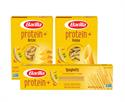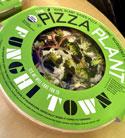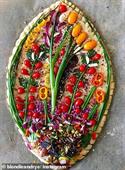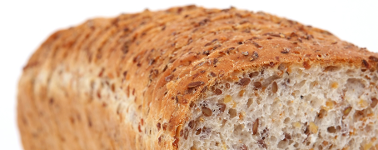Brands
Vegan Donut Bakery In California Evokes The Flavors Of Childhood
 Hole Foods Vegan Donuts (Salinas, California) serves vegan pastries with flavors that evoke the Latino food experiences of a childhood sharing with friends and family churros and baso de fruta with mango con chile. Husband-and-wife co-owners Eva and Steven Castro cultivated the flavors they grew up with when creating their pop-up business, The eatery hosts pop-up events at various locations around town, serving vegan and, whenever possible, organic treats. Fan favorite flavors like churro and blackberry are almost always available, while other specialty flavors like pumpkin and gingerbread are on rotation along with Mexican hot chocolate and mango con chile. The flavour lineup includes horchata, lemon poppy seed, blueberries, chocolate, chocolate with sprinkles, jamaica, chile mango, matcha, and s'mores.[Image Credit: © TEGLAN from Pixabay]
Hole Foods Vegan Donuts (Salinas, California) serves vegan pastries with flavors that evoke the Latino food experiences of a childhood sharing with friends and family churros and baso de fruta with mango con chile. Husband-and-wife co-owners Eva and Steven Castro cultivated the flavors they grew up with when creating their pop-up business, The eatery hosts pop-up events at various locations around town, serving vegan and, whenever possible, organic treats. Fan favorite flavors like churro and blackberry are almost always available, while other specialty flavors like pumpkin and gingerbread are on rotation along with Mexican hot chocolate and mango con chile. The flavour lineup includes horchata, lemon poppy seed, blueberries, chocolate, chocolate with sprinkles, jamaica, chile mango, matcha, and s'mores.[Image Credit: © TEGLAN from Pixabay]
Barilla’s Protein+ Pastas Are Now Made 100 Percent From Plant-Based Ingredients
 Pasta company Barilla Group announced its Protein+ line is now made entirely with plant-based ingredients, specifically semolina durum wheat mixed with protein from lentils, chickpeas, and peas. new recipe removes the egg whites from the formula, while maintaining the same great taste and "al dente" texture of traditional semolina pasta, the company says. The new formula includes shorter cook times to achieve al dente texture for all seven varieties: spaghetti, angel hair, thin spaghetti, farfalle, penne, elbows, and rotini. Protein+ pastas have the same amount of protein per serving (10g/2oz serving) as before, but now derived from plant-based sources. The pastas, a good source of iron, thiamin, folic acid, riboflavin, and niacin, are non-GMO project certified, vegan-certified, and kosher.[Image Credit: © PRNewsfoto/Barilla]
Pasta company Barilla Group announced its Protein+ line is now made entirely with plant-based ingredients, specifically semolina durum wheat mixed with protein from lentils, chickpeas, and peas. new recipe removes the egg whites from the formula, while maintaining the same great taste and "al dente" texture of traditional semolina pasta, the company says. The new formula includes shorter cook times to achieve al dente texture for all seven varieties: spaghetti, angel hair, thin spaghetti, farfalle, penne, elbows, and rotini. Protein+ pastas have the same amount of protein per serving (10g/2oz serving) as before, but now derived from plant-based sources. The pastas, a good source of iron, thiamin, folic acid, riboflavin, and niacin, are non-GMO project certified, vegan-certified, and kosher.[Image Credit: © PRNewsfoto/Barilla]
Einstein Bros.’s New Bagel-Burrito Mash-Up Launches Nationwide

Colorado-based Einstein Bros. Bagels has launched nationwide a bagel and burrito mash-up dubbed the Bagelrito after testing it successfully at five locations in the Denver area last October. The "big, bold and easy to hold" Bagelrito is made with two cage-free eggs, thick-cut bacon, turkey sausage, three cheeses, hash browns, salsa, and green chilies in a flour tortilla hand-wrapped in Asiago bagel dough and baked fresh. Einstein Bros. Bagels has more than 700 locations in 40 states and the District of Columbia. [Image Credit: © PRNewsfoto/Einstein Bros. Bagels]
Companies
Break Your New Year’s Resolutions At Hotels.com’s “Bread & Breakfast” In New York City
Innovation In Doughnuts Will Focus On Texture, Mix Marketer Says
California Bakery Expands To Whole Foods Markets In Two States With Plant-Based Pizzas

California-based Pizza Plant (Pasadena), known for its large 13-topping, CBD-infused, plant-based Nacho Pizzas, recently debuted a USDA certified organic take-and-bake plant-based pizza at Whole Foods Market locations in California, Arizona, and Nevada. Available organic plant-based pies include: house-made ancho chilled spiced tofu pepperoni slices, Italian spiced wheat crumble, bell peppers, onions, kalamata olives, and cashew nut cheese and marinara; roasted baby bella mushrooms, broccoli, house-made pumpkin seed pesto, red onion, and cashew nut cheese; and house-made Italian spiced wheat crumble, cured shiitake bits, shaved fennel, and cashew nut cheese and marinara. atop an artisan crust. The 10" pies are packaged in a microwavable TreeSaver Pizza Pan. Pizza Plant is a wholly-owned subsidiary of Plant Craft Foods, Inc.[Image Credit: © PRFoto/The Pizza Plant]
Sprouted Buckwheat Entrepreneur Slams Into A Coronavirus-Induced Supply Problem
 Whole Foods Market locations in Chicago this month will start selling a crunchy sprouted buckwheat breakfast cereal topping known as Lil Bucks. Creator of the brand Emily Griffith has been obsessed with sprouted buckwheat ever since she first tasted it in Australia. She hopes to expand into other Whole Foods regions in the future if the rollout proves successful. In Australia, sprouted buckwheat is a common health-food cereal, but in the U.S., buckwheat mostly appears in pancakes, soba noodles, and buckwheat groats, also called kasha. Technically not a grain, buckwheat is actually the seed of a fruit related to rhubarb and sorrel and is a highly-sustainable crop. It’s gluten-free, suitable for paleo diets, low on the glycemic Index, and high in magnesium and antioxidants. Unfortunately, Griffith has a supply problem: because she sources her buckwheat from China, “the coronavirus epidemic is affecting all parts of the supply chain, from logistics to labor,” she says. “Fortunately, we have enough buckwheat to get us through the next year at least.”[Image Credit: © LIL BUCKS LLC]
Whole Foods Market locations in Chicago this month will start selling a crunchy sprouted buckwheat breakfast cereal topping known as Lil Bucks. Creator of the brand Emily Griffith has been obsessed with sprouted buckwheat ever since she first tasted it in Australia. She hopes to expand into other Whole Foods regions in the future if the rollout proves successful. In Australia, sprouted buckwheat is a common health-food cereal, but in the U.S., buckwheat mostly appears in pancakes, soba noodles, and buckwheat groats, also called kasha. Technically not a grain, buckwheat is actually the seed of a fruit related to rhubarb and sorrel and is a highly-sustainable crop. It’s gluten-free, suitable for paleo diets, low on the glycemic Index, and high in magnesium and antioxidants. Unfortunately, Griffith has a supply problem: because she sources her buckwheat from China, “the coronavirus epidemic is affecting all parts of the supply chain, from logistics to labor,” she says. “Fortunately, we have enough buckwheat to get us through the next year at least.”[Image Credit: © LIL BUCKS LLC]
Hummus Pizza: A Marriage Of Two Popular Food Trends
 The plant-based meals craze has shouldered its way into Portland, Maine’s Olive Café and a couple of other eateries that combine two popular food trends – Middle Eastern hummus and pizza. The Olive Café began testing hummus pizza topped with fried okra as a special about two years ago. Grilled pizza restaurant Coals Bayside’s off-menu hummus pizza gained buzz at its locations in the Bronx and Port Chester, N.Y. Coals Bayside’s grilled pizza is topped with hummus, onions, cherry tomatoes, arugula, and spicy oil, and is vegan. In September, Maine's largest school district added hummus pizza to its lunch menu. The Mediterranean pie is "familiar to the kids and incorporates something for the vegans." The pizzas consist of flatbread and hummus with chopped vegetable toppings.[Image Credit: © muzo25 from Pixabay]
The plant-based meals craze has shouldered its way into Portland, Maine’s Olive Café and a couple of other eateries that combine two popular food trends – Middle Eastern hummus and pizza. The Olive Café began testing hummus pizza topped with fried okra as a special about two years ago. Grilled pizza restaurant Coals Bayside’s off-menu hummus pizza gained buzz at its locations in the Bronx and Port Chester, N.Y. Coals Bayside’s grilled pizza is topped with hummus, onions, cherry tomatoes, arugula, and spicy oil, and is vegan. In September, Maine's largest school district added hummus pizza to its lunch menu. The Mediterranean pie is "familiar to the kids and incorporates something for the vegans." The pizzas consist of flatbread and hummus with chopped vegetable toppings.[Image Credit: © muzo25 from Pixabay]
N.J. Bakery Uses “Old World Recipe” To Make 10,000 Loaves Of Bread Daily For Retail Grocers
 Anthony and Sons Bakery of Denville, N.J., operates a store and cafe where customers can sit and lunch on daily sandwich specials like The Cuban: roasted pork loin with Swiss, ham, and honey Dijon mustard between two slices of freshly baked bread. But behind that café – and the real money maker for the Dattolo family – is a 65,000-square-foot redbrick industrial building housing a wholesale bread baking operation that churns out 10,000 loaves of bread daily using 50,000 pounds of flour and an old-world recipe brought from Sicily to Brooklyn in 1952. The bakery employs 180 in Denville and the Succasunna area. Their loaves are frozen – applying a secret “EZ FreeZer to Oven” technology – and shipped to retailers including Wegmans, Wawa, Trader Joes, BJs, and Whole Foods.[Image Credit: © Anthony & Sons Bakery, Inc.]
Anthony and Sons Bakery of Denville, N.J., operates a store and cafe where customers can sit and lunch on daily sandwich specials like The Cuban: roasted pork loin with Swiss, ham, and honey Dijon mustard between two slices of freshly baked bread. But behind that café – and the real money maker for the Dattolo family – is a 65,000-square-foot redbrick industrial building housing a wholesale bread baking operation that churns out 10,000 loaves of bread daily using 50,000 pounds of flour and an old-world recipe brought from Sicily to Brooklyn in 1952. The bakery employs 180 in Denville and the Succasunna area. Their loaves are frozen – applying a secret “EZ FreeZer to Oven” technology – and shipped to retailers including Wegmans, Wawa, Trader Joes, BJs, and Whole Foods.[Image Credit: © Anthony & Sons Bakery, Inc.]
Sale Of Keebler Snack Business Puts A Dent In Kellogg’s 4th Quarter And 2020 Outlook
Mich.-Based Pizza Chain Offers Heart-Shaped Pies For Valentine’s Day
 Sterling Heights, Mich.-based Jet's Pizza is celebrating Valentine’s Day this year with heart-shaped pizzas, bread, and cinnamon stix on Valentine's Day. The heart-shaped pizza includes premium mozzarella and one topping. Jet's Pizza is known for its Detroit-style, deep-dish pizzas made using fresh-daily dough, grated premium mozzarella, hand-cut vegetables, and sauce made from vine-ripened tomatoes and a proprietary spice and herb blend. With more than 380 stores in 20 states, Jet’s was ranked No. 14 in Pizza Today's 2019 list of top 100 pizza companies in the U.S. by gross sales.[Image Credit: © Jet's Pizza®]
Sterling Heights, Mich.-based Jet's Pizza is celebrating Valentine’s Day this year with heart-shaped pizzas, bread, and cinnamon stix on Valentine's Day. The heart-shaped pizza includes premium mozzarella and one topping. Jet's Pizza is known for its Detroit-style, deep-dish pizzas made using fresh-daily dough, grated premium mozzarella, hand-cut vegetables, and sauce made from vine-ripened tomatoes and a proprietary spice and herb blend. With more than 380 stores in 20 states, Jet’s was ranked No. 14 in Pizza Today's 2019 list of top 100 pizza companies in the U.S. by gross sales.[Image Credit: © Jet's Pizza®]
Texas Bakery Goes All Out For The Special Days Of February

Houston’s Three Brothers Bakery says it’s ready for Valentine’s Day, Mardi Gras, and even Leap Day. Sales of its Louisiana-style King Cakes for the Mardi Gras season – said to be as good if not better than those sold in New Orleans – have been brisk, even though Fat Tuesday isn’t until February 25. For Valentine’s Day, the bakery conducts a "Decorating with Love" class at which couples learn to decorate a cake “while having a special time together.” Three Brothers ends the month on Leap Day (February 29) with a special in-store promotion involving a coupon good for $29 off any purchase on that rare quadrennial day.[Image Credit: © 3brothersbakery.com]
Nostalgia For Their Jewish Roots Draws Bay Area Entrepreneurs Into Baking
.jpg&width=125&height=70) Blame it on nostalgia for New York or Israel, or simply on a desire to launch a second career that harkens back to their early years. Whatever the reason, a number of entrepreneurs have opened (or re-opened) Jewish bakeries in the San Francisco Bay area recently. They include a kosher bagel shop in Berkeley; a bread bakery in San Leandro that specializes in making challah; and a home kitchen in Santa Clara that produces stretchy Yemeni flatbreads. New York native Sam Tobis, for example, moved to the Bay Area 12 years ago to attend UC Berkeley and decided to stay. Nevertheless, he longed for Jewish foods, ubiquitous in New York, and a connection to his roots. Three years ago he purchased Grand Bakery in Oakland, a long-running but now shuttered kosher bakery and has been evolving the 60-year-old legacy business, now a wholesaler, adding bagels as well as house-cured gravlax to the challah, hamentashen, and coconut macaroons that remain prominent offerings. Tobis may someday open a cafe that would expand Grand Bakery’s customer base beyond Jewish moms and rabbis.[Image Credit: © JAQ-WoJ from Pixabay]
Blame it on nostalgia for New York or Israel, or simply on a desire to launch a second career that harkens back to their early years. Whatever the reason, a number of entrepreneurs have opened (or re-opened) Jewish bakeries in the San Francisco Bay area recently. They include a kosher bagel shop in Berkeley; a bread bakery in San Leandro that specializes in making challah; and a home kitchen in Santa Clara that produces stretchy Yemeni flatbreads. New York native Sam Tobis, for example, moved to the Bay Area 12 years ago to attend UC Berkeley and decided to stay. Nevertheless, he longed for Jewish foods, ubiquitous in New York, and a connection to his roots. Three years ago he purchased Grand Bakery in Oakland, a long-running but now shuttered kosher bakery and has been evolving the 60-year-old legacy business, now a wholesaler, adding bagels as well as house-cured gravlax to the challah, hamentashen, and coconut macaroons that remain prominent offerings. Tobis may someday open a cafe that would expand Grand Bakery’s customer base beyond Jewish moms and rabbis.[Image Credit: © JAQ-WoJ from Pixabay]
A New Twist On An Old Jewish Pastry Arrives For Valentine’s Day

An Israeli-inspired bakery with four branches in New York City has been selling – yes, for Valentine’s Day – a red, gooey version of the traditional Jewish chocolate-filled pastry known as rugelach. The “roselach” at Breads Bakery are made with marzipan, rose water, and sprinkled with raspberry. Redolent of roses, the roselach was invented by an Israeli restaurateur who joined forces with a Turkish chef to honor the pagan-inspired holiday in America. Even though the roselach is a strictly Valentines-only treat, the hope is that the traditional chocolate version, made with high-quality ingredients and baked fresh daily, will sell well year-round. Meanwhile, the innovative roselach costs $36 for a box of a dozen in store, or $50 shipped. [Image Credit: © Breads Bakery]
Sara Lee Frozen To Acquire Cyrus O’Leary’s Pies
Consumers
Huge Market Opportunity Forecast Through 2026 For Pulse Flour Manufacturers
 Pulse flour manufacturers can expect to benefit from rising global consumption of snacks such as nutritious soups, sauces, and nutrition bars, according to new research from Fact.MR (Dublin, Ireland). The world pulse flour market is projected to accelerate at a surprising CAGR of more than 10 percent from 2020 to 2026 – double the growth rate of the global flour market. Pulse crops such as lentils, beans, peas, and chickpeas are a good source of amino acids and plant-based proteins, a reason they are being incorporated into gluten-free products. Demand for pulse flour is expected to create a $15 billion market opportunity into 2026.[Image Credit: © Fact.MR]
Pulse flour manufacturers can expect to benefit from rising global consumption of snacks such as nutritious soups, sauces, and nutrition bars, according to new research from Fact.MR (Dublin, Ireland). The world pulse flour market is projected to accelerate at a surprising CAGR of more than 10 percent from 2020 to 2026 – double the growth rate of the global flour market. Pulse crops such as lentils, beans, peas, and chickpeas are a good source of amino acids and plant-based proteins, a reason they are being incorporated into gluten-free products. Demand for pulse flour is expected to create a $15 billion market opportunity into 2026.[Image Credit: © Fact.MR]
Amateur Baker With a Passion For Artistic Flat Bread Ignites A Social Media Craze

An amateur baker and chef from Raleigh, N.C., whose passion is art and cooking, spends her time creating flatbreads elaborately decorated with colorful landscapes and intricate garden scenes. Blondie and Rye, as she is known on Instagram, uses thinly sliced spring onion for stems, spheres of beetroot for flowers, shredded capsicum for grass, and cherry tomatoes as rosebuds. Her handiwork has attracted the attention of an army of amateur bakers, with close to 95,000 Instagram followers keeping track of her “spectacular” breads, pastries and pies. The creations have spurred a craze for creative baking on social media.[Image Credit: © Blondie + Rye (Hannah P.) from Instagram]
Other
Retro Parker House Dinner Rolls Find New Life In Top Restaurants
.jpg&width=125&height=83) Parker House rolls, named after Boston’s Parker House Hotel where they originated in the mid-nineteenth century, are bucking a couple of trends in the U.S. baking industry. First, the bread and bakery products market is projected to grow at a dismal 1.5 percent from 2020 to 2023, but Parker House rolls are surging, at least among chefs. And second, they are supremely “anti-artisanal:” in fact, it’s hard to find a “whiter” dinner roll in this era of low-carb, high-protein diets. But the modest Parker House roll is finding a home in the kitchens of top restaurants across the country. Prominent San Francisco Bay Area chef Joshua Skenes, for example, has been making the rolls for eight years. His lard-glazed version is pre-baked then finished beside an open hearth and served piping hot with high-fat butter. The secret to the Skenes version is fresh-milled flour, he says. Cookbook author Mitchell Davis says Parker House rolls are the prime example of the “casualization” of chefs’ desires to upgrade homey foods.[Image Credit: © Sabine Schulte from Pixabay]
Parker House rolls, named after Boston’s Parker House Hotel where they originated in the mid-nineteenth century, are bucking a couple of trends in the U.S. baking industry. First, the bread and bakery products market is projected to grow at a dismal 1.5 percent from 2020 to 2023, but Parker House rolls are surging, at least among chefs. And second, they are supremely “anti-artisanal:” in fact, it’s hard to find a “whiter” dinner roll in this era of low-carb, high-protein diets. But the modest Parker House roll is finding a home in the kitchens of top restaurants across the country. Prominent San Francisco Bay Area chef Joshua Skenes, for example, has been making the rolls for eight years. His lard-glazed version is pre-baked then finished beside an open hearth and served piping hot with high-fat butter. The secret to the Skenes version is fresh-milled flour, he says. Cookbook author Mitchell Davis says Parker House rolls are the prime example of the “casualization” of chefs’ desires to upgrade homey foods.[Image Credit: © Sabine Schulte from Pixabay]
The Search For A Healthful Whole-Grain Bread That Appeals To The Masses
 Bread makers who consider themselves purists – healthful ingredients only, no preservatives or other additives, no pre-slicing, no pan baking, and no plastic packaging – have had to deal with a harsh reality: the market often rejects what they’re selling. As Vermont baker Blair Marvin discovered, some compromise has been necessary though the goal – a soft, sliced, affordable, and healthful whole wheat bread – is still the goal. So Marvin and colleagues in a baking collective that is helped by the famous Bread Lab of Washington State University are working toward making a whole-grain loaf that’s familiar-looking and affordable enough to appeal to a mass audience. The result, dubbed “The Approachable Loaf,” is now made in 20 states, as well as in England, Canada, and Australia. Disguised as a standard-issue sandwich bread that kids will eat, the loaf contains fiber and other nutritious ingredients, but no chemical preservatives or additives (i.e., flavor enhancers or sugars), found in mass-produced whole-wheat breads.[Image Credit: © Wolfgang Eckert from Pixabay]
Bread makers who consider themselves purists – healthful ingredients only, no preservatives or other additives, no pre-slicing, no pan baking, and no plastic packaging – have had to deal with a harsh reality: the market often rejects what they’re selling. As Vermont baker Blair Marvin discovered, some compromise has been necessary though the goal – a soft, sliced, affordable, and healthful whole wheat bread – is still the goal. So Marvin and colleagues in a baking collective that is helped by the famous Bread Lab of Washington State University are working toward making a whole-grain loaf that’s familiar-looking and affordable enough to appeal to a mass audience. The result, dubbed “The Approachable Loaf,” is now made in 20 states, as well as in England, Canada, and Australia. Disguised as a standard-issue sandwich bread that kids will eat, the loaf contains fiber and other nutritious ingredients, but no chemical preservatives or additives (i.e., flavor enhancers or sugars), found in mass-produced whole-wheat breads.[Image Credit: © Wolfgang Eckert from Pixabay]
Industry Experts Ask: Will The Current Success Of Sourdough Bread Endure?
 According to Nielsen data, total bread sales in the United States have been stagnant since 2015, showing little to no growth leading up to 2020. The phenomenon has made it hard for smaller players to stay afloat and has led to industry consolidation among big players. But one corner of the bread industry has shown signs of a comeback: sourdough bread sales grew about 11 percent from 2015 to 2019 to over $325.9 million, and sourdough is becoming more popular at restaurants. Last year, sourdough bread was on 14.3 percent of restaurant menus, up from 11.6 percent 10 years earlier. A Grand View Research study saw the market value of sourdough jump from $298.7 million in 2014 to $2.4 billion in 2018. But, industry observers wonder, is this a solid and enduring trend, or a flash in the pan?[Image Credit: © sandid from Pixabay]
According to Nielsen data, total bread sales in the United States have been stagnant since 2015, showing little to no growth leading up to 2020. The phenomenon has made it hard for smaller players to stay afloat and has led to industry consolidation among big players. But one corner of the bread industry has shown signs of a comeback: sourdough bread sales grew about 11 percent from 2015 to 2019 to over $325.9 million, and sourdough is becoming more popular at restaurants. Last year, sourdough bread was on 14.3 percent of restaurant menus, up from 11.6 percent 10 years earlier. A Grand View Research study saw the market value of sourdough jump from $298.7 million in 2014 to $2.4 billion in 2018. But, industry observers wonder, is this a solid and enduring trend, or a flash in the pan?[Image Credit: © sandid from Pixabay]
Research & Insights
Grains Should Be Major Part of Infant Diets – Study
Copyright 2025 Business360, Inc.

